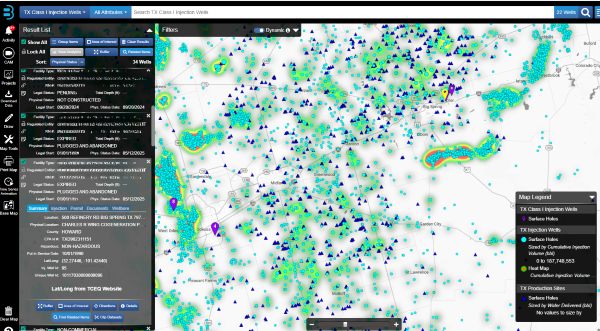B3 Insight has released three new datasets in OilfieldH2O, giving operators and midstream companies a clearer view of subsurface conditions, produced water handling, and infrastructure across Texas. These additions are designed to help technical teams plan with confidence, anticipate risks, and make faster decisions using the industry’s most comprehensive water and pressure intelligence platform.
Class I Wells Dataset: Extending Subsurface Visibility
Class I injection wells are now available statewide in OilfieldH2O. For the first time, operators can see:
- Facility and well locations and operational history
- Permit details, including permitted volumes and pressures
- Linked regulatory documents (when available)
This dataset broadens analysis beyond Class II disposal wells, supporting carbon capture and storage (CCUS) planning, Class II permitting workflows, and regional risk assessments.
Pro Tip: Layer Class I wells with Class II injection and production datasets to build a more complete picture of capacity and pressure dynamics

Recycling Facilities Dataset: Bringing Water Reuse Into Focus
Produced water recycling is playing a growing role in the Permian and across Texas, yet visibility into facilities and volumes has been limited. OilfieldH2O now reveals and maps recycling facilities and reported recycled volumes identified through RRC P-18 filings that were not previously visible including:
- Facility locations with geolocation accuracy
- Reported activity and recycled volumes
- Facility-level attributes for analysis
With these insights, operators can better monitor water reuse, connect production wells to recycling infrastructure, and optimize sourcing and offtake strategies.
Pro Tip: Use Recycling Facility analytics to track volumes over time, identify contributing operators, and link production with recycling destinations.
Orphaned Well Risk Score: Spotlighting Subsurface Risks
OilfieldH2O now includes a risk score for all RRC-designated orphaned wells in Texas, based on B3’s interpretation of the state’s rubric. Each well is assigned a score (1–4) along with a detailed scorecard showing the drivers behind the ranking.
This dataset helps identify orphaned wells that pose the greatest operational or regulatory risk—enabling proactive area of review (AOR) evaluations, regulatory filings, and field development planning.
Pro Tip: Review the orphaned well scorecard to refine drilling plans and mitigate potential risks near proposed locations.
With the addition of Class I wells, Recycling Facilities, and Orphaned Well Risk Scores, OilfieldH2O is the single most comprehensive view of water, pressure, and infrastructure in U.S. oil and gas.
From permitting to production and from planning to compliance, every decision is clearer with One Source.




